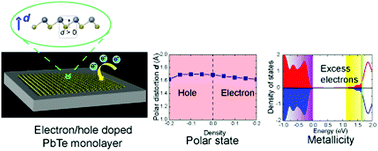Two-dimensional polar metal of a PbTe monolayer by electrostatic doping†
Abstract
Polar metals characterized by the simultaneous coexistence of a polar structure and metallicity have been a long-sought goal due to the promise of novel electronic devices. Developing such materials at low dimensions remains challenging since both conducting electrons and reduced dimensions are supposed to quench the polar state. Here, based on first-principles calculations, we report the discovery of a non-centrosymmetric polar structure in two-dimensional (2D) metallic materials with electrostatic doping, even though ferroelectricity is unconventional at the atomic scale. We revealed that the PbTe monolayer is intrinsically ferroelectric with pronounced out-of-plane electric polarization originating from its non-centrosymmetric buckled structure. Moreover, the polar distortions can be preserved with carrier doping in the monolayer, which further enables the doped PbTe monolayer to act as a 2D polar metal. With an effective Hamiltonian extracted from the parametrized energy space, we found that the special elastic-polar mode interaction is of great importance for the existence of robust polar instability (i.e., soft phonon mode associated with polar distortion) in the doped system. The application of this doping strategy is not specific to the present crystal, but is rather general to other 2D ferroelectrics to bring about the fascinating non-centrosymmetric metallic state. Our findings thus change the conventional knowledge in 2D materials and will facilitate the development of multifunctional materials in low dimensions.



 Please wait while we load your content...
Please wait while we load your content...